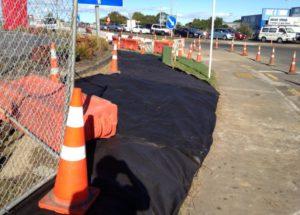Specific Tasks
Utilities
What, and issues to look out for
What
Utilities include electricity, gas, water, wastewater and telecommunications. Utilities are regularly upgraded or installed across Canterbury’s urban environments within berms and road reserves.
Issues to look out for
Installing services and utilities involves trenching and dewatering, so can cause significant disturbance to the ground surface, with resulting soil erosion and sedimentation.
During the sequence of development of new subdivisions, utilities and services are usually installed towards the end of the bulk earthworks. This means that trenching works may cross areas that have already been stabilised, and, in some cases, areas where sediment control measures have already been decommissioned. The trenches are often long and can cut across different water catchments.
Earthworks associated with the installation of utilities are usually fairly minor in any one area, but can create a cumulative effect. The works are often done along roads and close to stormwater inlets. Pumping groundwater and rainwater out of trenches generates sediment-laden water that can be difficult to treat in the roadway where these works are usually done. Use the tools in the dewatering section to manage these tasks well.
Design essentials
New subdivisions
- Install reticulation systems for water supply, stormwater and wastewater services and for other services and utilities at the same time as the road works.
- Coordinate installation of services and utilities with all relevant service providers and authorities, and, where possible, use common trenching.
- Make sure that trenching operators working in a larger site follow the ESC Plan for the site as a whole as well as with any specific ESC requirements for their particular project.
- Don’t trench across flowing streams or watercourses. Use alternative tools such as directional boring or aqueducts.
- For areas where ephemeral water is likely to concentrate, make a dam above the site with sandbags or similar. Then start the works and reinstate the surface with a stabilised surface.
- Plan the works to minimise both the extent and duration of site disturbance, especially in high-risk areas such as near watercourses and on slopes steeper than 18%.
- If trenching is finished independently of other activities on site, plan to progressively stabilise and/or restore the disturbed areas.
- Don’t leave trenches open for longer than three days. Stabilise all disturbance in high-risk areas within two days of backfilling, and within five days in all other areas.
Existing urban environments

Erosion of an unstabilised area where utilities are being installed is minimised by covering soils to protect them from rain.
- There is often limited space to construct conventional sediment control devices. Use a ‘cut and cover’ methodology and stabilise exposed areas at the end of each day’s operations.
- Don’t trench across flowing streams or watercourses. Use an alternative tool such as directional boring or aqueducts.
- Plan the works to minimise both the extent and duration of site disturbance, especially in high-risk areas such as areas near watercourses and on slopes steeper than 18%.
- When trenching has been completed independent of other activities on site, plan for progressive stabilisation and/or restoration of disturbed areas.
- Don’t leave trenches open for any longer than necessary; finish stabilising all disturbed areas immediately and progressively. Open trenches in an existing urban environment are also a safety issue.
Construction and operation
- If trenching works affect pre-existing ESC measures, remove those measures carefully then immediately reinstate them at the end of the works.
- You will usually need additional ESC contingency measures during the trenching and until the original measures are reinstated or replaced.
- Where practicable, plan and do works in appropriately sized stages so that trenching is not open for longer than three days, and can be stabilised within the range specified above.
- Don’t open trenches when there is a risk of high rainfall. An open trench becomes a diversion drain – consider where it will discharge.
- Divert above-site water away from work areas with temporary diversion drains. Don’t let the trench excavation concentrate or convey runoff (see Managing Clean Water section).
- Stockpile topsoil and spoil separately on the upslope side of the trench.
- Don’t put stockpiles of topsoil, spoil or bedding material in overland flow paths or within 1 m of hazard areas such as kerb and channels, stormwater inlets, paved footpaths or driveways.
- Minimise soil loss by protecting all stockpiles with covers such as geotextile fabric.
- Remove excess spoil and/or bedding material from the site as soon as work ends, or immediately incorporate it into other works on site.
- Backfill and compact trenches within three days and stabilise the area as soon as possible.
- Trench dewatering must not pollute any stormwater system or downstream watercourse. Pump sediment-laden water to a sediment retention device or to a tanker for appropriate offsite disposal.
- Stabilise disturbed verges and berms rapidly, so that they are not a source of sediment.
